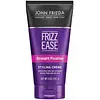What's inside
What's inside
 Key Ingredients
Key Ingredients

No key ingredients
 Benefits
Benefits

 Concerns
Concerns

 Ingredients Side-by-side
Ingredients Side-by-side

Water
Skin ConditioningDimethicone
EmollientCyclopentasiloxane
EmollientDimethiconol
EmollientAcrylamide/Sodium Acryloyldimethyltaurate Copolymer
Emulsion StabilisingPhenyl Trimethicone
Skin ConditioningPropylene Glycol
HumectantIsohexadecane
EmollientPhenoxyethanol
PreservativeParfum
MaskingPEG-8 Methicone
EmollientEthylhexyl Hydroxystearate
EmollientPolysorbate 80
EmulsifyingSorbitan Oleate
EmulsifyingPEG-4 Dilaurate
EmulsifyingPEG-4 Laurate
EmulsifyingIodopropynyl Butylcarbamate
PreservativePEG-4
HumectantSodium PCA
HumectantDimethicone PEG-8 Meadowfoamate
EmollientPanthenol
Skin ConditioningCinnamidopropyltrimonium Chloride
Amyl Cinnamal
PerfumingBenzyl Salicylate
PerfumingCitral
PerfumingCitronellol
PerfumingGeraniol
PerfumingHexyl Cinnamal
PerfumingHydroxycitronellal
PerfumingLimonene
PerfumingLinalool
PerfumingCI 77163
Cosmetic ColorantMica
Cosmetic ColorantCI 77891
Cosmetic ColorantWater, Dimethicone, Cyclopentasiloxane, Dimethiconol, Acrylamide/Sodium Acryloyldimethyltaurate Copolymer, Phenyl Trimethicone, Propylene Glycol, Isohexadecane, Phenoxyethanol, Parfum, PEG-8 Methicone, Ethylhexyl Hydroxystearate, Polysorbate 80, Sorbitan Oleate, PEG-4 Dilaurate, PEG-4 Laurate, Iodopropynyl Butylcarbamate, PEG-4, Sodium PCA, Dimethicone PEG-8 Meadowfoamate, Panthenol, Cinnamidopropyltrimonium Chloride, Amyl Cinnamal, Benzyl Salicylate, Citral, Citronellol, Geraniol, Hexyl Cinnamal, Hydroxycitronellal, Limonene, Linalool, CI 77163, Mica, CI 77891
Water
Skin ConditioningCyclopentasiloxane
EmollientCetearyl Alcohol
EmollientDimethicone
EmollientAlcohol
AntimicrobialStearyl Alcohol
EmollientGlyceryl Stearate
EmollientPEG-100 Stearate
Ceteareth-20
CleansingHydrolyzed Milk Protein
Skin ConditioningCocos Nucifera Oil
MaskingGardenia Taitensis Flower Extract
Skin ConditioningPrunus Amygdalus Dulcis Oil
Skin ConditioningPropylene Glycol
HumectantPolysilicone-9
Polyquaternium-10
Aminopropyl Dimethicone
Propylene Glycol Dicaprylate/Dicaprate
EmollientBehentrimonium Chloride
PreservativeParfum
MaskingDisodium EDTA
Cetrimonium Chloride
AntimicrobialQuaternium-91
Cetrimonium Methosulfate
AntimicrobialLaureth-23
CleansingLaureth-4
EmulsifyingPolyquaternium-55
Lactic Acid
BufferingSodium Hydroxide
BufferingMalic Acid
BufferingSodium Laneth-40 Maleate/Styrene Sulfonate Copolymer
Cetearyl Glucoside
EmulsifyingBenzyl Alcohol
PerfumingDiazolidinyl Urea
PreservativeIodopropynyl Butylcarbamate
PreservativeWater, Cyclopentasiloxane, Cetearyl Alcohol, Dimethicone, Alcohol, Stearyl Alcohol, Glyceryl Stearate, PEG-100 Stearate, Ceteareth-20, Hydrolyzed Milk Protein, Cocos Nucifera Oil, Gardenia Taitensis Flower Extract, Prunus Amygdalus Dulcis Oil, Propylene Glycol, Polysilicone-9, Polyquaternium-10, Aminopropyl Dimethicone, Propylene Glycol Dicaprylate/Dicaprate, Behentrimonium Chloride, Parfum, Disodium EDTA, Cetrimonium Chloride, Quaternium-91, Cetrimonium Methosulfate, Laureth-23, Laureth-4, Polyquaternium-55, Lactic Acid, Sodium Hydroxide, Malic Acid, Sodium Laneth-40 Maleate/Styrene Sulfonate Copolymer, Cetearyl Glucoside, Benzyl Alcohol, Diazolidinyl Urea, Iodopropynyl Butylcarbamate
Ingredients Explained
These ingredients are found in both products.
Ingredients higher up in an ingredient list are typically present in a larger amount.
Cyclopentasiloxane, or D5, is a silicone used to improve texture of products and trap moisture.
D5 is considered lightweight and volatile. Volatile means it evaporates quickly after application. Once evaporated, D5 leaves a thin barrier that helps keep skin hydrated.
It is also an emollient. Emollients help soften the skin and prevent water loss. Silicones create a silky texture in products. D5 helps other ingredients become more spreadable.
Studies show D5 is safe to use in skincare products. We recommend speaking with a skincare professional if you have concerns.
Learn more about CyclopentasiloxaneDimethicone is a type of synthetic silicone created from natural materials such as quartz.
What it does:
Dimethicone comes in different viscosities:
Depending on the viscosity, dimethicone has different properties.
Ingredients lists don't always show which type is used, so we recommend reaching out to the brand if you have questions about the viscosity.
This ingredient is unlikely to cause irritation because it does not get absorbed into skin. However, people with silicone allergies should be careful about using this ingredient.
Note: Dimethicone may contribute to pilling. This is because it is not oil or water soluble, so pilling may occur when layered with products. When mixed with heavy oils in a formula, the outcome is also quite greasy.
Learn more about DimethiconeIodopropynyl Butylcarbamate is a preservative.
Parfum is a catch-all term for an ingredient or more that is used to give a scent to products.
Also called "fragrance", this ingredient can be a blend of hundreds of chemicals or plant oils. This means every product with "fragrance" or "parfum" in the ingredients list is a different mixture.
For instance, Habanolide is a proprietary trade name for a specific aroma chemical. When used as a fragrance ingredient in cosmetics, most aroma chemicals fall under the broad labeling category of “FRAGRANCE” or “PARFUM” according to EU and US regulations.
The term 'parfum' or 'fragrance' is not regulated in many countries. In many cases, it is up to the brand to define this term.
For instance, many brands choose to label themselves as "fragrance-free" because they are not using synthetic fragrances. However, their products may still contain ingredients such as essential oils that are considered a fragrance by INCI standards.
One example is Calendula flower extract. Calendula is an essential oil that still imparts a scent or 'fragrance'.
Depending on the blend, the ingredients in the mixture can cause allergies and sensitivities on the skin. Some ingredients that are known EU allergens include linalool and citronellol.
Parfum can also be used to mask or cover an unpleasant scent.
The bottom line is: not all fragrances/parfum/ingredients are created equally. If you are worried about fragrances, we recommend taking a closer look at an ingredient. And of course, we always recommend speaking with a professional.
Learn more about ParfumPropylene Glycol is an odorless, colorless liquid. As a humectant, it helps skin retain moisture. It also aids in delivering active ingredients.
Another role of this ingredient is preventing a product from melting or freezing. Propylene glycol also adds antimicrobrial properties to a product, elongating product lifespan.
This ingredient is considered an organic alcohol and commonly added into both cosmetics and foods.
Those with sensitive skin or conditions may develop a rash when using this ingredient.
Learn more about Propylene GlycolWater. It's the most common cosmetic ingredient of all. You'll usually see it at the top of ingredient lists, meaning that it makes up the largest part of the product.
So why is it so popular? Water most often acts as a solvent - this means that it helps dissolve other ingredients into the formulation.
You'll also recognize water as that liquid we all need to stay alive. If you see this, drink a glass of water. Stay hydrated!
Learn more about Water